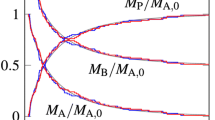Abstract
A reaction limited by standard diffusion is simulated stochastically to illustrate how the continuous time random walk (CTRW) formalism can be implemented with minimum statistical error. A step-by-step simulation of the diffusive random walk in one dimension reveals the fraction of surviving reactants P(t) as a function of time, and the time-dependent unimolecular reaction rate coefficient K(t). Accuracy is confirmed by comparing the time-dependent simulation to results from the analytical master equation, and the asymptotic solution to that of Fickian diffusion. An early transient feature is shown to arise from higher spatial harmonics in the Fourier distribution of walkers between reaction sites. Statistical ‘shot’ noise in the simulation is quantified along with the offset error due to the discrete time derivative, and an optimal simulation time interval \(\Delta t_0\) is derived to achieve minimal error in the finite time-difference estimation of the reaction rate. The number of walkers necessary to achieve a given error tolerance is derived, and \(W = 10^7\) walkers is shown to achieve an accuracy of \(\pm 0.2\%\) when the survival probability reaches \(P(t) \sim \frac{1}{3}\). The stochastic method presented here serves as an intuitive basis for understanding the CTRW formalism, and can be generalized to model anomalous diffusion-limited reactions to prespecified precision in regimes where the governing wait-time distributions have no analytical solution.





Similar content being viewed by others
References
Shlesinger MF (2017) Origins and applications of the Montroll–Weiss continuous time random walk. Eur Phys J B 90:93. https://doi.org/10.1140/epjb/e2017-80008-9
Scher H, Montroll EW (1975) Anomalous transit-time dispersion in amorphous solids. Phys Rev B 12:2455. https://doi.org/10.1103/PhysRevB.12.2455
Shlesinger MF, Montroll EW (1984) On the Williams–Watts function of dielectric relaxation. PNAS 81:1280–1283. https://doi.org/10.1073/pnas.81.4.1280
Ngai KL, Liu F-S (1981) Dispersive diffusion transport and noise, time-dependent diffusion coefficient, generalized Einstein–Nernst relation, and dispersive diffusion-controlled unimolecular and bimolecular reactions. APS Phys 24:1049. https://doi.org/10.1103/PhysRevB.24.1049
Shlesinger MF (2017) Origins and applications of the Montroll–Weiss continuous time random walk. Eur Phys J B 90:93. https://doi.org/10.1140/epjb/e2017-80008-9
Shlesinger MF (1979) Electron scavenging in glasses. J Chem Phys 70:4813. https://doi.org/10.1063/1.437370
Kenkre VM, Montroll EW, Shlesinger MF (1973) Generalized master equations for continuous-time random walks. J Stat Phys 9:45–50. https://doi.org/10.1007/BF01016796
Montroll EW, Scher H (1973) Random walks on lattices. IV. continuous-time walks and influence of absorbing boundaries. J Stat Phys 9:101–135. https://doi.org/10.1007/BF01016843
Montroll EW, Weiss GH (1965) Random walks on lattices II. J Math Phys 6:167. https://doi.org/10.1063/1.1704269
Laidler KJ, Meiser JH (1982) Physical chemistry. Benjamin/Cummings, Menlo Park, CA
Karaman MM, Sui Y, Wang H, Magin RL, Li Y, Zhou XJ (2016) Differentiating low- and high-grade pediatric brain tumors using a continuous-time random-walk diffusion model at high b-values. Mag Reson Med 76:1149. https://doi.org/10.1002/mrm.26012
Berezhkovskii A, Weiss GH (2008) Propagators and related descriptors for non-Markovian asymmetric random walks with and without boundaries. J Chem Phys 128:044914. https://doi.org/10.1063/1.2830254
Metzler R, Klafter J (2000) The random Walk’s guide to anomalous diffusion: a fractional dynamics approach. Phys Rep 339:1–77
Montroll EW (1964) Random walks on lattices. Am Math Soc 16:193–220. https://doi.org/10.1090/psapm/0161378
Klafter J, Sokolov IM (2011) First steps in random walks. Oxford University Press, New York
Montroll EW, Shlesinger MF (1984) On the wonderful world of random walks. In: Lebowitz JL, Montroll EW (eds) Studies in statistical mechanics, vol 11. Elsevier Science Pub. Co., New York, pp 46–116
Scher H, Lax M (1973) Stochastic transport in a disordered solid. I. Theory. Phys Rev B 7:4491. https://doi.org/10.1103/PhysRevB.7.4491
Montroll EW (1969) Random walks on lattices III. Calculation of first? Passage times with application to exciton trap** on photosynthetic units. J Math Phys 10:753. https://doi.org/10.1063/1.1664902
Hemenger RP, Pearlstein RM, Lakatos-Lindenberg K (1972) Incoherent exciton quenching on lattices. J Math Phys 13:1056. https://doi.org/10.1063/1.1666085
Gentle JE (2003) Random number generation and Monte Carlo methods. Springer, New York. https://doi.org/10.1007/b97336
Zorn R (2002) Logarithmic moments of relaxation time distributions. J Chem Phys 116:3204. https://doi.org/10.1063/1.1446035
Acknowledgements
This work was supported in part by NSF Grants DMREF-1729016, DMR-1720139, and ECCS-1912694, with additional support provided by Leslie and Mac McQuown.
Author information
Authors and Affiliations
Corresponding author
Ethics declarations
Conflict of interest
The authors declare that there are no conflicts of interest that are directly or indirectly related to the work submitted for publication. All data in the manuscript is freely available from the authors upon request.
Additional information
Publisher's Note
Springer Nature remains neutral with regard to jurisdictional claims in published maps and institutional affiliations.
Appendix: Continuum Limit for Survival Probability Distribution
Appendix: Continuum Limit for Survival Probability Distribution
The continuum expressions for the diffusion-limited reaction are detailed below. Using the following definition of the Fourier transform,
Eq. (33) can be expressed as
Taking advantage of the translation property of Fourier transforms, this can be written as
where the Fourier transform of G(x, t) is:
Applying the Poisson summation formula, yields
Inverting the Fourier transform and using Eqs. (55) and (57), the final expression for the time-dependent probability distribution becomes,
Spatial integration will then determine the survival probability as a function of time,
Rights and permissions
Springer Nature or its licensor (e.g. a society or other partner) holds exclusive rights to this article under a publishing agreement with the author(s) or other rightsholder(s); author self-archiving of the accepted manuscript version of this article is solely governed by the terms of such publishing agreement and applicable law.
About this article
Cite this article
Grayson, M.A., Kangabire, A., Aygen, C. et al. Stochastic Simulation of Continuous Time Random Walks: Minimizing Error in Time-Dependent Rate Coefficients for Diffusion-Limited Reactions. J Stat Theory Pract 17, 46 (2023). https://doi.org/10.1007/s42519-023-00343-6
Accepted:
Published:
DOI: https://doi.org/10.1007/s42519-023-00343-6




